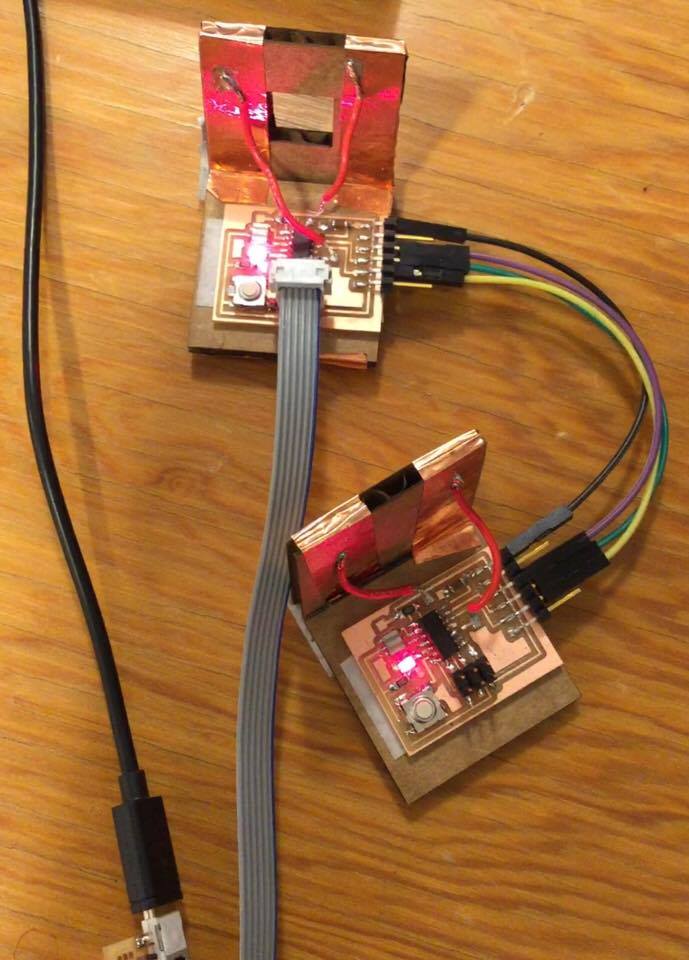Maroula Bacharidou
MAS.863 | How to Make (Almost) Anything
Networking and communications
*1. Assignment
2. Programming
*
1. Assignment
This week's assignment was to design and build a wired and/or wireless network connecting at least two processors. I re-designed and re-fabricate the conductive surfaces that I made back in week 8, this time adding a data and a "side" copper pad - which acts as a wire, so the communication would not be literally wireless..! I also designed two new boards that included pads to be connected withe teh respective pads on my conductive surfaces. Unfortunately, this plan did not work. In fact, I realized that making the copper pads attach closely is quite a challenge - my cardboard crosses, in the middle of which I planned to place my boards, did not attach perfectly with each other. Plus, there were some soldering issues on my new boards (see update 4 in my project updates page).
In order to work through the assignment, I used the data-less and side-less (in terms of pads) that I made during the input devices week. My initial goal was to wirelessly connect the two processors using the conductive pads that I designed and made then. I was happy to learn how to program my boards interact - the coding part this week was tough, and I was taught a lot of new things by reading online and getting advice from coding gurus.

Figure 1. Wired connecting two processors and making them interact.
Video 1. The plan that worked.
2. Programming
Programming was challenging this week. I worked eith the master-and-slave mode, sending bytes from the one to the other, getting responses and blinking lights between them.
Here is the code I wrote for the master:const int led = 8; const int data = 0; const int pad = 1; const int ms = 100; void setup() { pinMode(led, OUTPUT); pinMode(data, INPUT); digitalWrite(data, HIGH); pinMode(pad, INPUT); digitalWrite(pad, HIGH); } void sendByte(unsigned int x, int show) { for(int i=0;i<8;i++) { if(show) digitalWrite(led, (x>>(7-i))&1); digitalWrite(data, (x>>(7-i))&1); delay(ms); } } void sendData(unsigned int x) { sendByte(0b010101100,0); sendByte(x,1); sendByte(0b010101101,0); } unsigned int readData() { unsigned int h = 0, x = 0, f = 0; while(1) { h = 0; while(h!=0b010101100) { h = (h<<1) | digitalRead(data); h &= 0xff; delay(ms); } x = 0; for(int i=0;i<8;i++) { x = (x<<1) | digitalRead(data); delay(ms); }; f = 0; for(int i=0;i<8;i++) { f = (f<<1) | digitalRead(data); delay(ms); } if(f == 0b010101101) { return x; } } return -1; } unsigned int x = 0; void loop() { pinMode(data, OUTPUT); digitalWrite(data, HIGH); x++; sendData(x); pinMode(data, INPUT); digitalWrite(data, HIGH); x = readData(); delay(ms); //sendData(1); //sendData(0); }
The code I wrote for the child board is similar to that of the master's:
const int led = 8; const int data = 0; const int pad = 1; const int ms = 100; void setup() { pinMode(led, OUTPUT); pinMode(data, INPUT); digitalWrite(data, HIGH); pinMode(pad, INPUT); digitalWrite(pad, HIGH); } void sendByte(unsigned int x, int show) { for(int i=0;i<8;i++) { if(show) digitalWrite(led, (x>>(7-i))&1); digitalWrite(data, (x>>(7-i))&1); delay(ms); } } void sendData(unsigned int x) { sendByte(0b010101100,0); sendByte(x,1); sendByte(0b010101101,0); } unsigned int readData() { unsigned int h = 0, x = 0, f = 0; while(1) { h = 0; while(h!=0b010101100) { h = (h<<1) | digitalRead(data); h &= 0xff; delay(ms); } //sendByte(0b10101010); x = 0; for(int i=0;i<8;i++) { x = (x<<1) | digitalRead(data); delay(ms); }; f = 0; for(int i=0;i<8;i++) { f = (f<<1) | digitalRead(data); delay(ms); } if(f == 0b010101101) { return x; } } return -1; } void loop() { pinMode(data, INPUT); digitalWrite(data, HIGH); unsigned int x = readData()+1; delay(ms); pinMode(data, OUTPUT); digitalWrite(data, HIGH); sendData(x); }